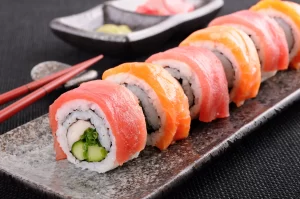One of the most amazing meals from the ocean, tuna is adored by dietitians and food enthusiasts alike. Even if they are fantastic, tuna comes in a wide variety and differs greatly from one another. So how can one choose a healthy tuna meal? You will learn precisely that today.
Despite what the general public believes, tuna is a group of fish that include over a dozen different species. However, out of all the species of Tuna in the sea, only five make for a regular meal option, at least in Western countries.
Skipjack, Albacore, Yellowfin, Bigeye, and Bluefin Tuna are among them. There is a difference in taste, color, and meat texture among these five tunas. Because of these traits, some species are more appropriate for salads, while others are great for steak or sushi.
But the variety doesn’t end there. It is more difficult to find some varieties of tuna than others. This may result in some wildly disparate prices amongst them. Let’s compare these five species of tuna.
Skipjack Tuna
The type of tuna that is most frequently canned is skipjack, which is small in size and has a dark meat color. Actually, Skipjacks accounts for more than 70% of the canned tuna market in the US. Their flesh has a soft quality that makes it ideal for canning in small portions.
Skipjack tuna has a powerful flavor that is frequently characterized as “fishy.” The likelihood is that you are looking at a can of Skipjack when you see “Chunk Light” on the label. Because of their comparatively brief life cycles, skipjack tunas’ mate at a fairly young age (one year old).
This implies that they have probably already hatched at least once in their lifetimes when they are discovered. Because of this, there is no known threat to the stocks of skipjacks, making them a plentiful species.
Tuna Albacore
With almost 20% of the market, albacore tuna is the second most popular canned kind in the US. Albacores, sometimes known as “White Tuna,” have delicate flesh and a subtle flavor. When compared to Skipjacks, they are typically more expensive and come in larger portions.
They are also a great option for grilling because their meat holds together well. The fact that albacore tuna has three times the mercury content of skipjacks raises some concerns. The Environmental Defense Fund advises against consuming too much white tuna because of this. Albacores are still widely distributed in terms of conservation.
Yellowfin Tuna
Yellowfin tuna, with their delicate pink color and gentle taste, are arguably the most adaptable type of tuna to eat. These fish are available in sushi and steak forms, as well as in cans. For a few reasons, Yellowfin is a well-liked sushi choice in the US.
One is that, although it isn’t as expensive as Bluefin Tuna, it is still rather good value. Two, compared to Bluefin and Bigeye, whose higher fat content results in a considerably more noticeable taste, its meat is much thinner and gentler tasting.
Yellowfins are typically served as tuna steaks, and they are reasonably priced when found in restaurants. Yellowfin can easily be found in a supermarket or seafood store if you want to cook it yourself.
Bigeye tuna
Bigeye tuna are robust, large fish with bright, substantial meat that is bursting with flavor. For those who enjoy fatty, tasty fish but don’t want to spend a lot of money on it, these fish are a terrific alternative. That’s not to imply that Bigeye are inexpensive; at restaurants, a decent serving of sashimi can cost more than $20.
Still, $20 for a Bigeye sashimi seems like a good deal, especially when you consider that Bluefins frequently cost four times as much. Bigeye tuna are considered “vulnerable” by the IUCN due to the possibility of overfishing in recent years. If you decide to get a Bigeye steak from the grocery store, be sure to read the label to see whether
Tuna with Blue Fins
It is a well-founded belief that bluefins are the kings of the tuna family. A variety of physical characteristics give bluefins a flavor depth that is unmatched by other fish.
The most common way to find bluefin tuna is as sushi. High-end restaurants carry them; the price range for a single piece is $20 to $200. In Japan, these fish are very well-liked. So popular, that local restaurants are willing to pay millions of dollars to get their hands on a single Bluefin!
Despite all of their amazing traits, bluefins are a declining species. Southern and Atlantic Bluefins have been overfished to the point that they’ve become severely endangered.
Steer clear of the Southern and Atlantic Bluefin if you enjoy superb sashimi but would prefer to see bluefins survive another day. Opt for Pacific Bluefin instead; they’re equally delicious!
Various Tuna Types: A Choice for Any Occasion
Tunas are a terrific source of vitamins, as well as an outstanding taste meal alternative. These fish, which are high in omega-3 fatty acids and protein, ought to be on your plate.
Tuna is as wonderful as it gets, whether it’s served as an energizing salad, a sandwich to go, or an indulgent steak or sashimi. You will know exactly which variety of tuna to eat next now that you are aware of their distinctions!
For affordable and quality fish, Unimitra Seafood has the most reliable wholesale frozen tuna fish exporter, you can get free quotes and fast shipments for wholesale fishing.



